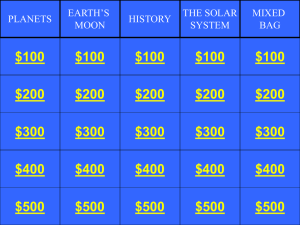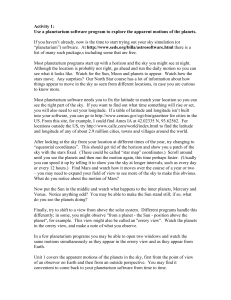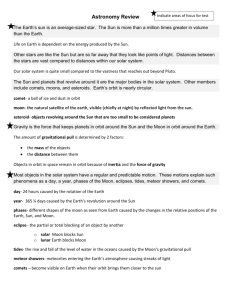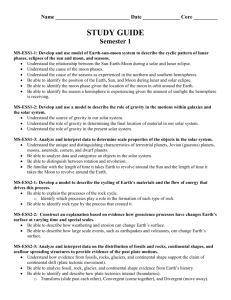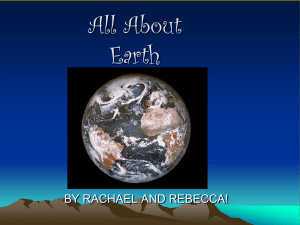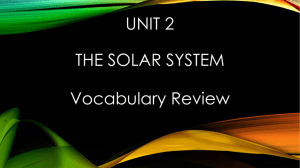Lesson Plan for Earth, Moon, and Sun
advertisement
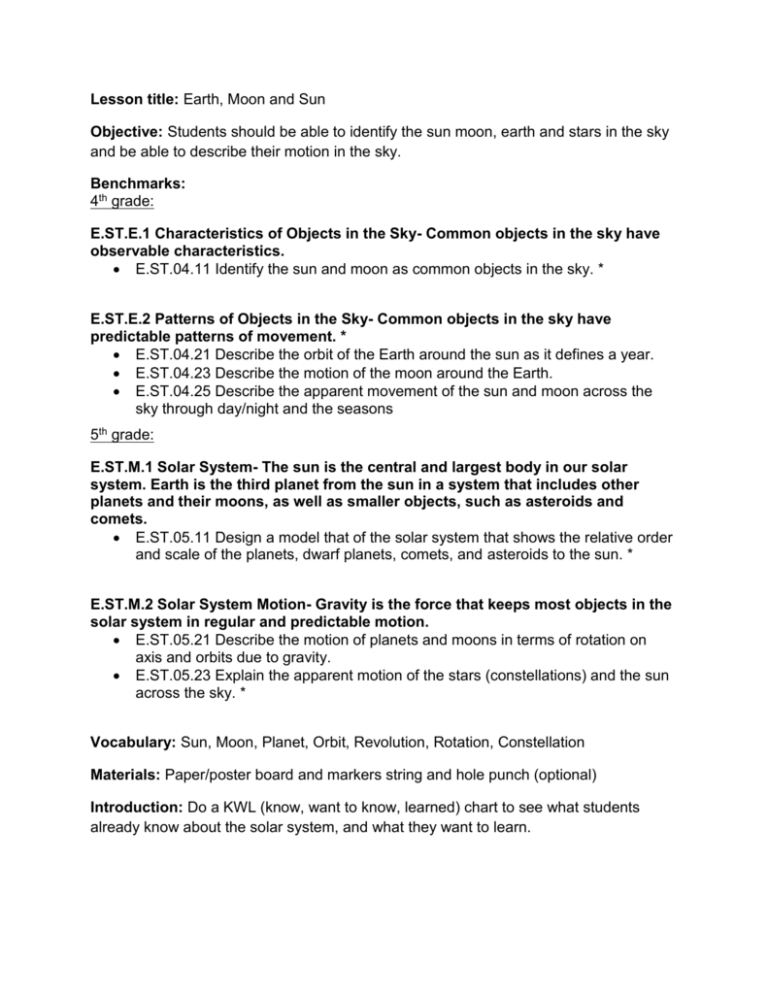
Lesson title: Earth, Moon and Sun Objective: Students should be able to identify the sun moon, earth and stars in the sky and be able to describe their motion in the sky. Benchmarks: 4th grade: E.ST.E.1 Characteristics of Objects in the Sky- Common objects in the sky have observable characteristics. E.ST.04.11 Identify the sun and moon as common objects in the sky. * E.ST.E.2 Patterns of Objects in the Sky- Common objects in the sky have predictable patterns of movement. * E.ST.04.21 Describe the orbit of the Earth around the sun as it defines a year. E.ST.04.23 Describe the motion of the moon around the Earth. E.ST.04.25 Describe the apparent movement of the sun and moon across the sky through day/night and the seasons 5th grade: E.ST.M.1 Solar System- The sun is the central and largest body in our solar system. Earth is the third planet from the sun in a system that includes other planets and their moons, as well as smaller objects, such as asteroids and comets. E.ST.05.11 Design a model that of the solar system that shows the relative order and scale of the planets, dwarf planets, comets, and asteroids to the sun. * E.ST.M.2 Solar System Motion- Gravity is the force that keeps most objects in the solar system in regular and predictable motion. E.ST.05.21 Describe the motion of planets and moons in terms of rotation on axis and orbits due to gravity. E.ST.05.23 Explain the apparent motion of the stars (constellations) and the sun across the sky. * Vocabulary: Sun, Moon, Planet, Orbit, Revolution, Rotation, Constellation Materials: Paper/poster board and markers string and hole punch (optional) Introduction: Do a KWL (know, want to know, learned) chart to see what students already know about the solar system, and what they want to learn. Introduce vocabulary about the solar system to students by discussing planets, the moon, stars and the sun as things we can see in the sky. The following website can be used for animations on how revolving and rotation work: http://www.bbc.co.uk/schools/scienceclips/ages/9_10/earth_sun_moon.shtml Pre-show activity options: Option 1: Have students separate into 9 groups Assign 8 of the groups each a different planet and have the 9th group be the sun. Have each group of students make a sign using poster board representing the size of their planet and decorate with the name of the planet on them. Using their signs to represent each planet, have the students put the planets in the correct orbit order in space Have the students show what the orbit around the sun would look like. Also explain rotation, that as the planets orbit the sun they rotate on their axis. Option 2: Have the students create a 2D diagram of the solar system on a whiteboard/chalkboard. Have the students correctly place the sun at the center Help them to establish 8 orbits increasing in size around the sun. Have the students place the planets in their correct orbits. Then have a class discussion on revolution and rotation. Planetarium Show: Tell the students to pick out a few facts during the show to share as their favorite after the show is over with. Have the students watch the show at the Adrian College planetarium. Post-show activity: Have the students share some interesting facts they learned from the planetarium show. Students should complete their KWL charts and turn them in to see what was learned and what students still do not know. 5th grade students should be able to create a model of the solar system that is able to show the relative size and scale of the planets after the show is over. 4th grade students should be able to answer questions about the way things move in the sky. Assessments: Students will be assessed on their completion of the KWL chart, including a complete L column of what the students have learned after the planetarium visit. KWL Chart Topic: __________________________ Before learning about your topic fill out the K and W column with what you know about the topic and what you think you want to learn about the topic. When you have learned more about the topic answer the questions you had in the learned column, and add any new facts you learned K W L What do you know? What do you want to learn? What have you learned?




